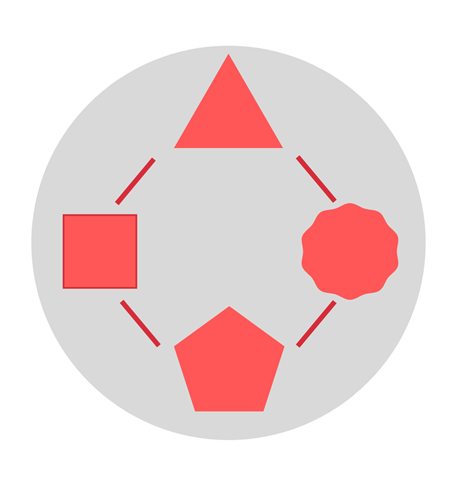For the longest time, a monolith architecture was the default for development teams across the world.
In the past 20 years, Microservices have also gained a foothold in the market.
Microservices as a software architecture has made its way into the development teams of popular companies like Netflix or Google, or any company that needed to scale their services.
And it’s a decent choice – it offers flexibility, scalability and agility for the product or service you’re putting together.
But that doesn’t mean you should drop monolith altogether.
So let’s check the pros and cons of each architecture and determine what’s best for your company.
What We Took Into Account
This is a showdown between software architectures, so it’s hard to crown an objective winner.
The choice between monolith and microservices has a lot to do with your project requirements, like how latent, reliable, scalable and complex it is.
In different situations, a different architecture might be best for your company. For example, if you want a product that can scale to serve more markets in the future, microservices might be right for you. If you expect a lot of debugging to take place, a monolith architecture is better suited for your project.
So we wanted to round this showdown up based on the latency, reliability, scalability and complexity of each architecture. But then we realized that might not provide the necessary insight into what each option can do for your business. You’d need to scroll up and down to find information on each criteria, which will take up a lot of your time.
So to make things easier for you, we decided to talk about each architecture in turn, pointing out the advantages and disadvantages of both.
Monolith Architecture: Simple and Straightforward
Building something with a monolith architecture means developing a single deliverable – one or more databases, one front-end, one server-side application. You take all features of your product and build them as an indivisible unit.

This architecture used to be the norm in development.
And that’s because it’s simple to understand and apply.
It also has some other advantages:
- Easy to test – everything’s available in the same place
- Easy to deploy – one file, one directory
- Easy to develop – With a monolith architecture, the code gets bigger and harder to develop the bigger the project becomes. Microservices helps you keep productivity high.
However, monolith has fallen out of grace in some companies, especially when you consider the rise of agile development and the need to adapt to an ever shifting market. If that sounds interesting, you can read our article on moving your business from offline to online.
But let’s get back to our showdown.
Monolith disadvantages include:
- Hard to scale – changes need to be done across the board, for all the moving parts
- Hard to understand – the bigger your software gets, the harder it is for new developers and architects to pick it up
- Compatibility – applying new technologies to a monolith application could lead to a ton of compatibility issues, since the whole app needs to work with that new tech
So you can see how monolith software might not be the best choice for your development needs.
Now let’s talk about an alternative.
Microservices Architecture: Scalable and Modular
Microservices is an architecture with a focus on developing multiple units as part of a larger product.

We hope the image paints a clear picture.
But if you still want to wrap your head around it, imagine a CRM that has:
- A main dashboard
- Orders management
- Lead management
- Email delivery
With a monolithic architecture, the entire CRM is built all together, with the same logic and in a single deliverable.

With microservices architecture, you build each component separately. So that’s a different deliverable and database for the main dashboard, orders, leads and email delivery.
Sure, some of the common modules may be needed to be shared between all components, but we’ll not get into this part.
But at its core, a microservices architecture is modular. Each component is its own unit.
And that comes with a few benefits:
- It’s flexible – because all components are their own individual unit, it’s easier to make changes, update a product with new technology, and rework parts of the software
- It’s understandable – in a microservices infrastructure, individual elements can be picked up by anyone, regardless of the stage of development. That’s not as easy with a monolithic architecture.
- It’s scalable – Since you can scale individual parts of your software, it’s easier and cheaper to scale with a microservices architecture.
- It’s adaptable – Being able to make changes faster, to individual elements of your software, means you can quickly adapt to market changes.
But that doesn’t mean it’s a perfect infrastructure, and a lot of companies both big and small still create monoliths, even if some of them end up rebuilding the software with a microservices architecture later on.
So what are the problems when building microservices?
- Deployment is a bit tougher, since you need to distribute all the moving parts.
- Testing is harder than with a monolith, since you have to debug all units individually.
- Complexity is also something to take into account. You’re creating user-facing interfaces, server-side code and a database for all individual units, which means you’ll need to find an effective way to make all of them work together.
However, take the necessary precautions and microservices could prove to be exactly what you need in a fast evolving market.
Now you know what each architecture is good for.
So how do you choose what to use?
Picking The Right Architecture For You

When choosing an option between microservices and monolithic architectures, you need to take into account what team size you have, how complex your software will be, your Go To Market strategy, and what resources you have at your disposal.
So we recommend you choose building with a monolithic architecture when:
- Your team size is on the small end
- You have a clear launch window in mind
- Your app is pretty simple in scope
- You don’t have access to consultancy and development experts
However, if you want to enjoy the benefits of microservices architecture, make sure you have:
- A complex project that implies uncertainty in future patches
- A big enough team to support the creation of that project
- Enough resources
And we want to underline that final part. Microservices need complex infrastructures to tie in place all the modules, user journeys, and databases. That’s also why we recommend hiring DevOps and Containers experts to advise on the creation of such a complex software.
Microservices can help you take a product to the next level. If you want to find out more about microservices, you have to read Sam Newman’s book on Building Microservices. Martin Fowler’s Microservices Guide also provides a lot of insights into the system.
But pulling that off requires expertise and hard work.
Luckily, we can help you with that.
Who We Are
Abac’s work is defined by the use of available technology in order to optimize and extend the possibilities that are available to humankind.
Our mission is to help startups and mature enterprises in designing, developing and maintaining software products that will bring value to their businesses.
So if you feel that you need help developing a microservices product, get in touch.
We’ll be happy to help.

